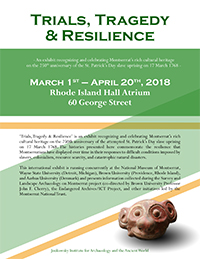"Trials, Tragedy & Resilience" is an exhibit recognizing and celebrating Montserrat’s rich cultural heritage on the 250th anniversary of the attempted St. Patrick’s Day slave uprising on 17 March 1768. The histories presented here commemorate the resilience that Montserratians have displayed over time in their responses to difficult conditions imposed by slavery, colonialism, resource scarcity, and catastrophic natural disasters. This international exhibit is running concurrently at the National Museum of Montserrat, Wayne State University (Detroit, Michigan), Brown University (Providence, Rhode Island), and Aarhus University (Denmark) and presents information collected during the Survey and Landscape Archaeology on Montserrat project (co-directed by Brown University Professor John F. Cherry), the Endangered Archives/ICT Project, and other initiatives led by the Montserrat National Trust.
Montserrat is a small island (102km2) and British Overseas Territory located in the Caribbean Lesser Antilles. First inhabited by Amerindian peoples around 4,000 years ago, Montserrat has been home to many different cultural groups over the course of its human history. Some of these groups freely migrated to Montserrat, while others, like enslaved Africans, were brought against their will during the plantation era. Lasting contributions from Amerindian, African, Irish, and British inhabitants survive in the surnames, place-names, food, architecture, flora, landscape, and material culture of the island.
Montserrat has been radically transformed in the past two decades by the Soufriere Hills volcano. Beginning in 1995, pyroclastic flows from the eruptions buried the former capital city of Plymouth, rendered the southern half of the island an inaccessible Exclusion Zone, displaced two-thirds of the population, and killed nineteen residents. The volcano is still active. Demonstrating Montserratian resilience in the face of disaster, the island has recently reconfigured its settlements and society to accommodate a new way of life in the island’s north.

